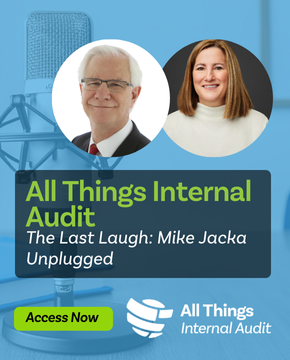New to internal auditing? Build a strong foundation with Tools for New Auditors! This course covers essential skills, industry best practices, and practical insights to help you succeed in the profession. Enroll today and take the first step in your internal audit journey!
-
HOST:
Hello, welcome to Getting Started With, where our job is to make your job easier.On this episode, we are Getting Started With Root Cause Analysis or RCA. Whether you’re investigating an audit finding, a control failure, or a process inefficiency, RCA is your secret weapon for solving problems at the source.
By the end of this video, you’ll have a solid understanding of what RCA is, why it matters, and how you can use it to drive meaningful improvements in your organization.
So, let’s get started!
What is Root Cause Analysis?
The IIA defines it as:
a technique for finding the core causes for problems an organization may face. Auditors can use a variety of identification and measurement tools for determining the root cause of the issues they analyze.Think of RCA like fixing a leaky roof. You can keep mopping up the puddles on the floor, which addresses the symptoms, or you can climb up and patch the hole in the roof, which addresses the root cause.
RCA is a method used by internal auditors to identify the underlying cause of an issue rather than just treating its symptoms. By finding and addressing the root cause, organizations can prevent the issue from recurring rather than continuously applying quick fixes.RCA is a ‘Useful Tool’ because it helps internal auditors go beyond surface-level findings to provide lasting solutions.
Why is Root Cause Analysis Important?
Imagine an internal audit team notices that purchase orders are frequently missing approvals. They could simply report the issue and move on — or they could ask why this keeps happening.
By identifying the true cause, auditors help organizations fix the system.
Here's why that’s a game-changer:It Identifies underlying issues.
RCA helps auditors go beyond surface-level symptoms to uncover the fundamental causes of problems. This ensures that corrective actions address the root of the issue, preventing recurrence.It enhances audit effectiveness:
By understanding the root causes, internal auditors provide stronger, more effective recommendations that lead to lasting improvements.It improves risk management.
RCA helps uncover systemic risks that might otherwise go unnoticed, making the organization more resilient and strengthening the overall risk management framework.It adds value to the organization.
When internal auditors use RCA, they contribute to the organization's long-term success by promoting a culture of continuous improvement and proactive problem-solving.It streamlines audit reports.
RCA can help auditors group multiple findings into fewer, more comprehensive root causes. This makes audit reports clearer and more insightful and easier for management to act on.
It analyzes culture and governance: RCA isn’t just about processes — it can help auditors understand and address organizational culture and governance weaknesses.
Using RCA in audit engagements is a ‘time saver’ because it helps prevent recurring issues and reduces future audit workload.There are several RCA techniques, but one of the simplest and most effective is the Five Whys Method. Here’s how it works:
- Define the problem: A high number of expense reports are missing receipts.
- Ask why: Why are receipts missing? Employees forget to attach them.
- Ask why again: Why do they forget? The system doesn’t remind them.
- Keep going: Why doesn’t the system remind them? There’s no automated alert.
- One more time: Why isn’t there an alert? It was never configured in the system.
Bingo! Instead of repeatedly chasing down receipts, the real solution is to configure an automated reminder.
While the Five Whys method is a great starting point, some issues require a more structured approach. Let’s look at other RCA techniques that can provide deeper insights and help tackle complex problems.
Three Legged Five Whys:
This method examines prevention, detection, and recovery to identify multiple root causes.
Fishbone Diagram (Ishikawa):
A visual way to categorize potential causes of a problem.Pareto Analysis:
Prioritizing the most significant factors contributing to the issue.Failure Mode and Effects Analysis:
Evaluating potential failures in a process before they happenHere’s a Bright Idea:
Using a combination of RCA methods can provide a clearer picture of the root cause.Root Cause Analysis is a powerful tool for auditors because it helps move beyond surface-level findings. Instead of simply reporting, “The organization lacks effective monitoring controls,” auditors using RCA can pinpoint:
- Whether the issue stems from inadequate training,
- A lack of leadership oversight,
- Poorly designed IT systems, or
- A culture that deprioritizes compliance.
By providing actionable recommendations, auditors can help organizations fix problems for good instead of constantly fighting fires.
Save time by documenting RCA from the start. The IIA’s Global Internal Audit Standards now require internal auditors to document root cause analysis as part of their audit methodology. To streamline your work, integrate RCA into your planning and fieldwork phases, so findings are properly documented early — saving time during reporting and ensuring conformance with the Standards.
If you’re new to RCA, here’s how to integrate it into your audit process:
- Ask why – Don’t stop at surface-level symptoms.
- Use structured methods – Whether it’s Five Whys, Fishbone, or another technique, having a method ensures thorough analysis.
- Look for patterns – Recurring issues often share a common root cause.
- Differentiate causes – Understand the difference between immediate, contributing, and root causes.
- Document findings – Clearly communicating root causes and recommendations makes your audit reports more valuable.
Here’s a PRO TIP:
Set up early touchpoints with stakeholders to validate root cause findings and ensure alignment on corrective actions.HOST
Congratulations on completing Getting Started With: Root Cause Analysis! Now you have the tools to uncover the true causes of issues, making your audit work even more impactful.
Check out the links below to access helpful resources, including tools, podcasts and training.There’s much more to learn!
Get the Transcript


